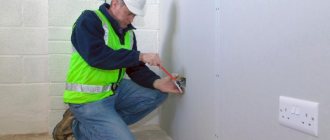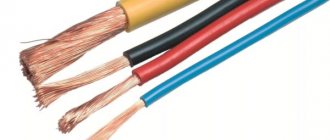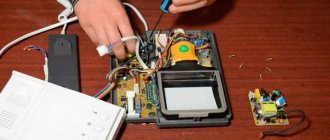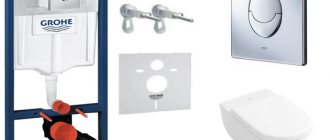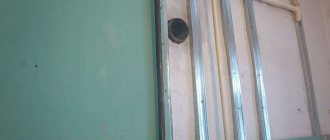Installing an electrical outlet is one of the most common household electrical jobs. Therefore, it is important to learn how to do this work yourself, especially since the level of knowledge required to perform this work does not exceed the level of knowledge of physics of the 9th grade, and this work does not require special physical effort and the presence of complex tools. In this article we will take a detailed look at how to properly install sockets with your own hands.
Preparing for work
Decide on the type of outlet
There is a huge variety of electrical outlets that differ in purpose, type of design, installation method and the presence of additional functions. In this case, we will consider sockets used in Russia and designed for 220 V.
Depending on the type, the method of installing sockets differs.
- Soviet-style socket, without grounding. This type of socket is intended for electrical appliances whose housing does not require grounding. Their main disadvantage, in addition to the lack of grounding, is that the plugs of modern electrical appliances simply do not fit into the sockets due to the difference in diameters and the presence of side protrusions. Therefore, only old-style or low-power electrical appliances with the appropriate type of plug can be connected to this outlet.
- "Euro socket" with grounding. Suitable for all modern electrical appliances. Main advantages: tight contact, there is an additional contact for connecting the ground wire, which is very important to eliminate the risk of electric shock for electrical appliances such as a washing machine, refrigerator, electric stove, water boiler.
- Socket for electric stove. As the name suggests, this type of socket is installed to connect an electric stove. This is a power outlet that can withstand connected power up to 7 kW or more.
- Internal socket. Installed in a special box installed in a recess in the wall. Used for hidden electrical wiring.
- External (surface) socket. It is mainly used in rooms with external electrical wiring.
Selecting a connection diagram
If we are not talking about replacing an old outlet, but about installing a new one, you will have to choose the optimal connection scheme.
The following schemes exist:
- Parallel connection. With this scheme, a separate wire from the junction box goes to each outlet. Used to connect high power electrical appliances.
- Serial connection. All sockets are connected one after another to one wire. It is preferable when connecting low-power devices to these sockets.
- Mixed connection when using both circuits at the same time (some sockets are connected in series, some in parallel).
Diagram of serial connection of sockets
Power outage
Before starting any electrical work, including installing a socket, you must turn off the power supply by unscrewing the plugs/turning off the circuit breakers and using an indicator screwdriver, make sure there is no voltage.
Required Tools
You will need:
- pliers;
- voltage indicator;
- screwdriver;
- construction knife.
Socket power: how to calculate?
An important characteristic of sockets is its rated voltage and current. Modern household sockets, designed for standard electrical appliances, have a maximum current of 16 A. This indicator will determine the total power consumption of electrical appliances connected to the socket. The power of the outlet will be 16 A x 220 V = 3520 W.
For comparison, the power of old Soviet sockets was only 6A (1320 W) and 10 A (2200 W). Therefore, if there are still old-style connectors in the room, you should not connect powerful consumers to them, for example, an air conditioner or an oil radiator, since the contact material may not withstand it and the socket will simply melt.
Installation and connection of an outdoor outlet without grounding
This type of sockets is installed if:
- The wiring in the house is laid on top of the walls.
- The wiring in the house is internal, but the installation of a new outlet is required, for which there is no desire to punch through and then re-align the wall. It’s easier to pull a wire from the nearest outlet or from a distribution box in a cable channel.
- When installing an outlet in utility rooms.
Operating procedure:
- To gain access to the contacts of the socket, it must be disassembled by unscrewing the bolt securing the housing to the base.
- The socket has two contacts to which the phase and neutral wires must be connected. To do this, the stripped ends of the wires should be inserted into special connectors and tightened with bolts. Polarity does not matter in this case.
- Next, attach the base of the socket to the wall. If the wall is not concrete, then you can install it on self-tapping screws. On a concrete or brick wall, having previously marked the attachment points, drill holes and hammer in dowels.
- Before installing the socket housing on the base, using a construction knife, cut an opening for the passage of the wire according to the existing markings.
- Place the prepared body on the cover and tighten the fastening bolt.
Attention! When connecting wires to the socket contacts, you must tighten the bolts tightly. A loose fit of the conductors to each other causes oxidation of the contacts, as a result of which the degree of their heating increases and the acceleration of oxidation.
Outdoor socket without grounding
This problem can later lead to wiring malfunction, and there are frequent cases of fires due to overheated electrical wiring.
Features of installation in a panel house
Panel houses have nuances:
- for electrical wiring installed using the open method, there is no need to drill a place for the box;
- in the case of closed electrical wiring, grooves for conductors will be required, while the cable is laid in a corrugation.
It is necessary to use corrugation. It protects the conductor from breaking, which can lead to short circuits and inoperability of sockets and switches.
The box can be fixed using gypsum mortar. When it dries, the process of connecting the electrical fittings continues. Electrical sockets are a must-have attribute in the home. Based on the type of installation, they are divided into overhead and internal. The choice depends on the type of wiring. The connection method is the same and does not cause any difficulties. Even an ordinary person can connect the outlet. It is only important to follow the installation instructions and safety requirements when working with wires.
Installation and connection of an outdoor outlet with grounding
By the appearance of the outlet you can determine whether it is grounded or not. The presence of metal protruding contacts on both sides of the socket allows it to be connected to three-wire wiring with grounding.
Operating procedure:
- Strip the ends of the home electrical wiring wires where the outlet is installed.
- After unscrewing the fastening bolt, disassemble the socket.
- The socket terminal block contains three contacts. Connect the phase and neutral wires to the side contacts, polarity does not matter, and the ground wire (yellow-green) to the central contact.
- Having tightened the contacts tightly, attach the connected terminal block to the wall using self-tapping screws or dowels (on a concrete wall).
- Cut an opening in the housing at the marked location for the wire to pass through, using a knife or wire cutters. Install the socket housing onto the terminal block and tighten the bolt.
Outdoor socket with grounding
Types of socket faults
Unfortunately, nothing lasts forever. Electric points also fall under this formulation.
The most common situation leading to replacement is a breakdown of contact at the point of their connection as a result of deformation of the internal structure. This is due to natural wear and tear of the equipment, the duration of which depends solely on the quality of the device. Mechanical impact is also often the cause: many people do not hold the mounting box with their hand when disconnecting the plug, which leads to loosening, and ultimately to tearing out the entire structure.
♥Read also “Selecting and installing a metal entrance door.”
The situations described are the main problems when the outlet breaks down. The information presented below will allow you to competently and competently carry out not only installation, but also replacement.
Installation and connection of an internal socket
The installation of an internal socket is significantly different from the installation of an external socket; it is used when the home electrical wiring is hidden (internal). In this case, a special installation box for the socket is used. Boxes are produced in various modifications depending on the material of the wall where the box is mounted.
Operating procedure:
- At the place where the electrical wiring exits, make a niche - a recess in the wall for the box.
- Install the box in the niche, bring out the wires with a good margin into it, secure the box with alabaster or other similar solution. If the box is mounted in drywall, then a box “with ears” is used, which, when tightening the screws, tightly presses the box to the drywall.
- To avoid sharp bends in the wires, secure them in the box in the form of a snake.
- Remove the top cover of the outlet.
- After stripping the ends of the wires located in the box, guide them into the sockets of the socket and tighten the fastening bolts. The tighter the bolts are tightened, the more secure it is.
- Secure the socket body in the installation box using screws.
- Install the top cover of the outlet.
Installation of distribution boxes
The size and configuration of the junction box depends on the number of wire connections and the environment in which it is installed. The hidden junction box is protected by itself, with only a cover on the outside. It comes in two types: with or without a protective pad. In the first case, the lid has a rubber ring that seals its connection with the junction box. In the second, the cover is attached with screws or simply snapped into the grooves.
A power cable approaches the junction box from below and splits into several outgoing wires.
When installing cables in plastic pipes, regardless of the type of installation, the pipe should extend into the box by 1–3 cm, without leaving the cable unprotected. This also applies to installation boxes. If the box is small, you can use a diamond core bit to drill a hole for it, just as you would to drill out a hole for an outlet or switch. The diameter of the box in this case should not exceed 70–100 mm.
A power cable approaches the junction box from below and splits into several outgoing wires.
If the box is larger, using the same bit, several holes are drilled side by side, and then the hole is trimmed with a chisel. The depth of the recess should be such that the closed box lid is flush with the wall surface.
Pipes should fit 1–3 cm into electrical boxes
The next stage of installation is to insert all the connected wires inside the box. There are plastic hatches at the bottom of the box or on the sides that can be broken off as needed. The ends of the cables are inserted into these holes. The wires are then connected to each other using terminal blocks, caps, clamps, clamps, or hand twisting.
Junction box with cover removed
The wires can be additionally wrapped with electrical tape. After this, the wires are twisted, hidden in a box and covered with a lid. Then the box is inserted into the recess and fixed in it with plaster or plaster. In addition, almost all types of boxes can be attached using dowel nails or screws.
Wire connection diagram in a distribution box for one socket
Connecting a double socket
In modern homes, there are more and more electrical appliances, and accordingly, more sockets are required. Installing additional sockets is quite a labor-intensive task, especially if there is internal wiring, so a good solution is to replace a single socket with a double one.
Attention! It should be remembered that its throughput remains the same, that is, it is not designed for the simultaneous connection of powerful electrical appliances.
Installation of a double socket is similar to the installation of a regular, single socket. After all, in essence, this is the same thing: in fact, one terminal box is connected, to which two sockets connected to each other are connected.
Moving an outlet or switch
Changing the location inevitably involves cable routing. In the case of external modifications, there are no special problems, but before installing an outlet in the house that is built into a new place, you have to carefully plan everything.
The labor-intensive process of changing wiring, especially when working in concrete, is caused by the need to groove the wall, that is, punch out a new channel. You can do this using several tools:
- hammer drill;
- perforator;
- angle grinder;
- wall chaser
They are listed in order of increasing cable installation costs.
Correct installation of an electric stove socket
The appearance of a new stove in the kitchen is necessarily accompanied by work on connecting it. Despite the apparent complexity, you can do everything yourself without calling an electrician.
Attention! The difference between a power outlet for an electric stove and a regular one is that it can withstand a fairly large connected power. In modern electrolytes, the power is up to 8 kW. Regular sockets are not designed for this and can melt.
Installing a socket for an electric stove involves certain preparatory measures:
- To power the electric stove, it is recommended to have a separate power line coming from the machine at 25A. The wiring can be made of copper wire with a cross-section of at least 4 sq. mm.
- If a separate line is not connected to the electric stove, then power from the general home network is possible from 40A circuit breakers, but it should be borne in mind that when other electrical appliances with high power consumption are turned on simultaneously with the electric stove, the circuit breakers will trip and turn off.
Plug and socket for electric stove
The choice of socket model depends on the following parameters:
- Electric stove power. The most common sockets for electric stoves are designed for a current of 40A and 63A, used when connecting stoves with a power of up to 7 kW and more than 7 kW, respectively.
- Number of phases. The peculiarity of electric stoves is that they can be connected to both single-phase and three-phase lines. In this case, we are considering connecting an electric stove to single-phase wiring, since apartments and most private houses do not have a power input.
- Installation method. Sockets can be for both indoor and outdoor installation. The choice depends on the method of laying home electrical wiring.
- Availability of grounding. In modern city apartments, grounding is sometimes provided, so the choice is clear. In apartments of old construction and private houses, if there is no grounding, we strongly recommend that you install it and install a grounded socket, because due to the high power, the presence of a metal casing and a large area, the stove is an object of increased danger.
The algorithm for installing an external or internal socket for connecting an electric stove in the kitchen is similar to installing conventional sockets of a similar type of installation. The main difference is in the connection diagram.
Connecting a socket for an electric stove
Operating procedure:
- Read the connection diagram given in the technical data sheet for the electric stove.
- Turn off the power supply. Prepare the outlet connection point. To do this, secure the installation box for the internal socket and strip the wires.
- Route the wires into the installation box and connect the socket so that the ground wire is connected to the top connector of the socket. The two lower connectors are for phase and neutral wires; polarity does not matter. After tightening the bolts, secure the socket body with plaster or similar mortar. Install the cover.
- Connect the electric stove cord, which is a three-core cable with a cross-section depending on the rated current of the machine. In many models, the electric stove cord often has to be purchased separately and connected independently. On the back panel of the electric stove there is a diagram for connecting the cable cores (cord) to the terminal block. Unlike conventional electrical appliances, there are six terminals in the terminal block of an electric stove. The manufacturer usually pre-installs jumpers for connecting to a 220 V network.
- Connect the plug to the cable. We connect the phase, neutral and ground wires in such a way that the plugs of the plug and the corresponding connectors in the socket match in polarity.
- By plugging the plug into the socket, we check the functionality of the stove.
Installation of the socket block
Internal sockets can be single or double. But if you need to place an internal socket with three or more sockets in one place, then you need to use an outlet block.
The socket block is a special single sockets that are combined into a single structure by a common frame.
A separate socket box is installed for each socket of the block. The power cable is connected to only one socket in the block, and the rest are powered by jumpers.
Connection diagram for the socket block
Below is a photo of the socket boxes in plasterboard for installing the socket block. In adjacent socket boxes, remove adjacent plugs for cable routing:
The photo below shows an example of a Sedna socket for a socket block:
And this is what the frame for a socket block with four sockets looks like:
As mentioned above, to connect the sockets in the block, jumpers from the cable cores are used:
Jumpers - phase, neutral and grounding for connecting sockets in the block.
Places for connecting cable cores in a socket:
An example of connecting sockets in a block. The power cable goes to the first socket, and the 2nd, 3rd and 4th are connected by jumpers:
All sockets are installed and connected:
Installation of the front panels of sockets and the frame is completed:
Rules for the location of sockets in the kitchen
Electrical outlets are present in every room of the house or apartment. However, most household electrical appliances are located in the kitchen, and those that must always be plugged in, for example, a refrigerator, electric stove, kettle and others. Therefore, there are certain rules for installing sockets in the kitchen:
- Do not install sockets near the sink or gas stove.
- Since the kitchen is often a high-humidity area, it is important to ensure that electrical wiring and contacts are waterproof.
- During electrical installation work, do not interfere with water supply, gas pipelines, or ventilation.
- To protect sockets located near the working surface of kitchen furniture from the ingress of water and other liquids, you can install sockets with special covers.
- For an electric stove, it is necessary to provide a separate circuit breaker in the electrical panel.
How everything works
Anyone with basic skills can now connect an outlet from a switch. We will try to talk in detail about all the problems that may arise in such situations.
An electrical outlet should under no circumstances become a source of all sorts of dangerous situations. This is especially true for houses and apartments where there are many energy-intensive appliances. Here you will have to seriously understand the entire structure. You must become familiar with the entire switchgear.
The socket is equipped with decorative elements that are secured with screws. There is also a sub-socket and block on which the frame, grounding, front panel, protection curtains, phase, protective mechanism and housing are located. Don't forget about the fastening tabs, contacts and terminals.
Safety regulations
Installing an outlet, like any type of electrical installation work, requires strict adherence to safety regulations:
- Before starting work, you must turn off the power by turning off the machine/unscrewing the plug in the electrical panel and make sure that there is no voltage using the indicator.
- Take measures to prevent the supply of electricity: warn household members, install a warning sign on the landing.
- Check the serviceability of the tools used, paying special attention to the integrity of the insulation.
Having familiarized yourself with the main stages and subtleties of installing a socket, you can do this work, which previously seemed incredibly difficult, with your own hands. After all, everything happens for the first time, and the most experienced electricians once also took their first steps in mastering these skills.
Notes
Socket connection diagrams may be different. On some, the terminals are connected directly to the contacts using screws. Sometimes they are installed directly with contacts - this is extremely reliable and effective. Treat all areas with conductive paste before connecting. After lubrication, you need to tighten everything with screws.
It is more difficult to install pads whose legs move. But they help adjust the height and inclination on the wall. It is recommended to choose pads that have two teeth on the feet. They will last much longer and will not wobble before their expiration date.
The terminals can be in the form of screws or a “brush”. The second option is more reliable, but it does not have the possibility of overhaul. The screw version is lubricated with cold solder.
general characteristics
The innovative electrical outlet can be easily hidden when not in use.
Hidden outlets are installed when there is internal (hidden) wiring in the room. They are mainly built into the wall, and on top there is only a decorative strip. When turned on, the plug of the electrical appliance is fixed with a special clamping mechanism.
Circuit type
Recessed sockets in the wall are usually divided into devices with and without grounding. The first option is equipped with a special part that provides a protective function. But this type of device is installed exclusively in those rooms where there is a grounding wire. They are equipped with pin sockets responsible for grounding supply.
Sockets of this type are ideal for turning on a refrigerator or freezer. They are installed for electric stoves, ovens, and air conditioners. Options without grounding are two-pin. They are installed in rooms where there is two-wire wiring.
Moisture protection
Block of waterproof sockets of overhead type.
Sockets are usually divided into ordinary (standard) and waterproof. The first option can be installed in residential premises, in offices.
Devices with increased moisture protection are ideal for the bathroom, kitchen, and sauna. They realize their function due to the presence of a special rubber membrane in the design. Such models are often equipped with a plastic cover, which additionally protects against moisture penetration.
Number of pads
Sockets can be single, double or triple. The first type has only one socket for turning on electrical appliances. Such models can be used in any room. Double and triple options are mainly used in the kitchen, where there is a need to simultaneously connect several appliances to the network.
Installation instructions
In order for electrical installation work to be successful, it is necessary to adhere to a strict sequence of operations.
Preparatory stage
Installation of socket boxes
The place on the wall where the installation will be carried out is marked with a marker. To create a niche where you can subsequently hide the body of the device, use a hammer and chisel. To speed up installation work, use an electric drill. When choosing a tool, be sure to take into account the material from which the wall is made. The formed niche should have a certain depth and smooth edges, which will simplify the subsequent installation of the device body.
To install the socket box, building mixtures are used - plaster, gypsum, adhesives. The box should completely cover the hole. The resulting cracks must be filled with the selected composition. Installation work continues only after the adhesives have hardened.
Connecting the socket to the network
Connecting the socket to the network
The electrical wire must exit through the hole in the wiring box. To facilitate further work, it is fixed with a special clamp.
To connect the contacts of the block with the wires of the electrical network, the latter are first cleaned. It is recommended to connect the zeros first, then the phase and grounding. Screws and a spring mechanism are used to secure the wires.
Additional recommendations
To fix the blocks on the socket box, sliding tabs or screws are used. Lastly, install the plastic decorative strip.
When installing floor hatches, a special box is used to install sockets. It can not be used when installation is carried out on the surface of the countertop.



